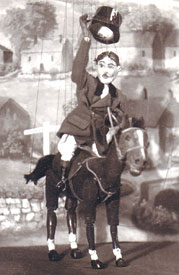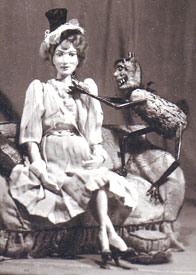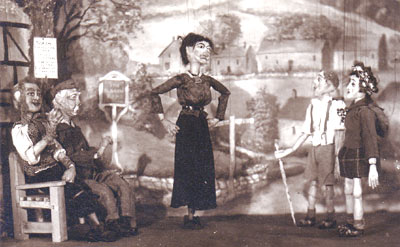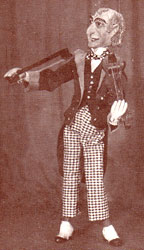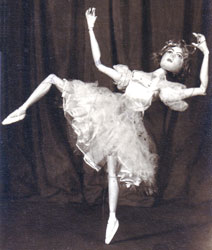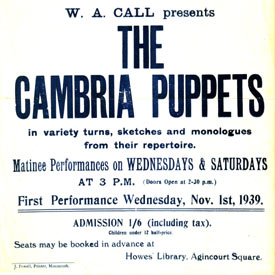The troupe first appeared in public in October 1938 at the Annual Exhibition of the British Puppet & Model Theatre Guild held in London at Victory House, Leicester Square. Here, they were given a most flattering reception, daily stage shows being given as well as continual floor demonstrations for the benefit of visitors, who showed the greatest interest and were in some cases invited to try their hands at pulling the strings.
Performances were subsequently given all over the country including Cheltenham Town Hall, Blackpool Tower, Warrington, Bolton, Manchester, Cambridge among many other towns. In July 1939, they were invited to make the first colour and sound film with marionettes. Unfortunately, the outbreak of war prevented any further developments in this line. The Cambria Puppets had their headquarters at Monmouth, where a permanent theatre was housed above W A Call's Photography Shop and performances were given two or three times weekly throughout the year.
The shows were aimed at an adult audience and ran about one and a half hours, with very elaborate stage lighting, scenery and props. The programme usually consisted of short plays, variety turns and caricature sketches, often based on recognisable local characters. The marionettes were costumed by Call's daughter, Queenie, who was also the Assistant Manipulator for the shows. By the early 1950s, the popularity of the marionette performances in Monmouth was steadily declining. As it was becoming increasingly difficult to fill even the tiny 35-seat auditorium, the shows were gradually wound down and performances eventually ceased. W A Call died in 1965 at the age of 87. After his death, the marionettes were not found in his shop, where he lived in the basement and if they are still in existence, their current whereabouts is not known. PROGRAMME
- PART 1 - MADEMOISELLE PLASTICINE (Trapeze Artist) POMPINELLO THE CLOWN and his pole balancing act THE EXTRAVAGANT MISS DAPHNE AND BINKIE MADEMOISELLE VERONIQUE (Cabaret Star)
PROFESSOR GLISSANDO (The World’s most conceited Violinist) MONSIEUR LAPATTE DE GUIMAUVE (Xylophone Artist) MADEMOISELLE YVETTE retires for the night SNOWDROP, JOSEPHINE AND UNCLE RASTUS OOPSIE AND DAISY (Acrobats) MRS GUPPY AND MRS GARBAGE (Our Theatre Charladies)
MADAME KICKEMOVA (of the Russian Ballet) THE GRAND SULTAN OF HASSAN AND HIS MANY WIVES MR
NOBODY AND PARTNER -
PART 2 - A FABLE OF THE LYBIAN DESERT Music by Tchaikovsky DIGGING TOO DEEP (A rustic play) THE RIVAL MAGICIANS (a fantasy) THE PIPES OF PAN (Woodland Ballet)
Puppets manufactured and operated by W A CALL
|
From a
Cambria Puppets Publicity Leaflet with additional
research
|
|

